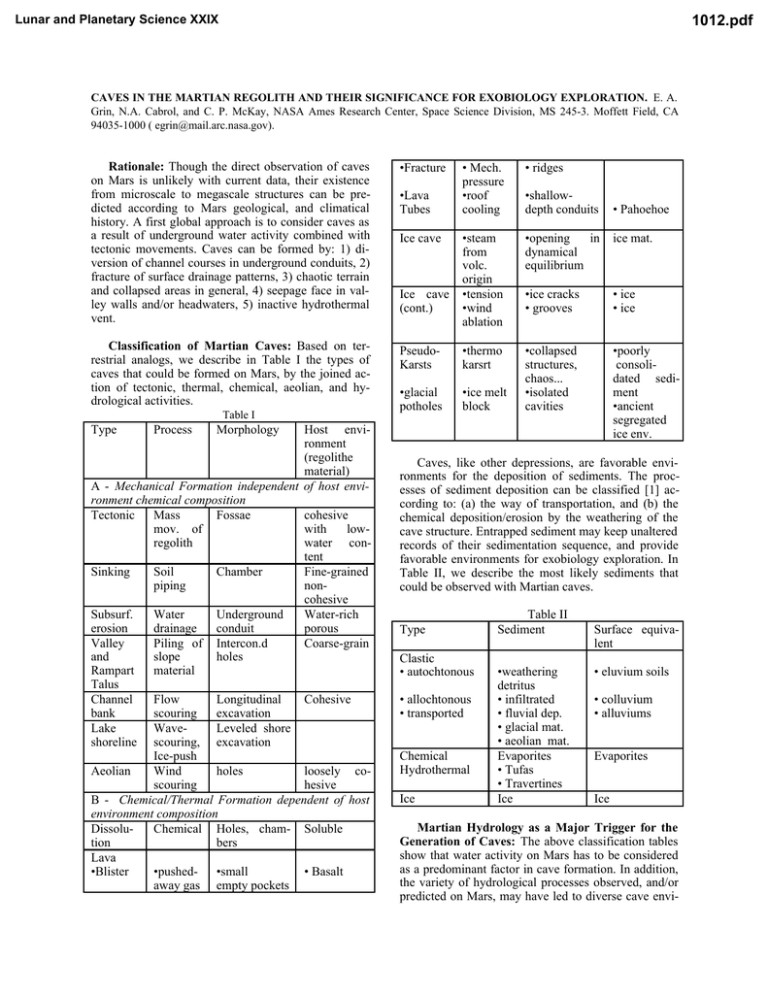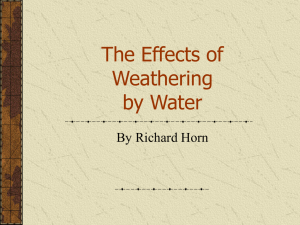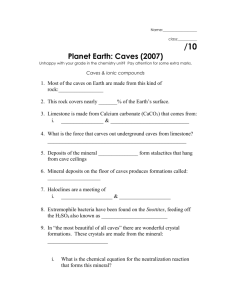Rationale: Though the direct observation of caves on Mars is
advertisement

Lunar and Planetary Science XXIX 1012.pdf CAVES IN THE MARTIAN REGOLITH AND THEIR SIGNIFICANCE FOR EXOBIOLOGY EXPLORATION. E. A. Grin, N.A. Cabrol, and C. P. McKay, NASA Ames Research Center, Space Science Division, MS 245-3. Moffett Field, CA 94035-1000 ( egrin@mail.arc.nasa.gov). Rationale: Though the direct observation of caves on Mars is unlikely with current data, their existence from microscale to megascale structures can be predicted according to Mars geological, and climatical history. A first global approach is to consider caves as a result of underground water activity combined with tectonic movements. Caves can be formed by: 1) diversion of channel courses in underground conduits, 2) fracture of surface drainage patterns, 3) chaotic terrain and collapsed areas in general, 4) seepage face in valley walls and/or headwaters, 5) inactive hydrothermal vent. •Fracture Classification of Martian Caves: Based on terrestrial analogs, we describe in Table I the types of caves that could be formed on Mars, by the joined action of tectonic, thermal, chemical, aeolian, and hydrological activities. Table I Type Process Host environment (regolithe material) A - Mechanical Formation independent of host environment chemical composition Tectonic Mass Fossae cohesive mov. of with lowregolith water content Sinking Soil Chamber Fine-grained piping noncohesive Subsurf. Water Underground Water-rich erosion drainage conduit porous Valley Piling of Intercon.d Coarse-grain and slope holes Rampart material Talus Channel Flow Longitudinal Cohesive bank scouring excavation Lake WaveLeveled shore shoreline scouring, excavation Ice-push Aeolian Wind holes loosely coscouring hesive B - Chemical/Thermal Formation dependent of host environment composition DissoluChemical Holes, cham- Soluble tion bers Lava •Blister •pushed- •small • Basalt away gas empty pockets • Mech. pressure •roof cooling • ridges •steam from volc. origin •tension •wind ablation •opening in dynamical equilibrium ice mat. •ice cracks • grooves • ice • ice PseudoKarsts •thermo karsrt •glacial potholes •ice melt block •collapsed structures, chaos... •isolated cavities •poorly consolidated sediment •ancient segregated ice env. •Lava Tubes Ice cave Ice cave (cont.) •shallowdepth conduits Morphology • Pahoehoe Caves, like other depressions, are favorable environments for the deposition of sediments. The processes of sediment deposition can be classified [1] according to: (a) the way of transportation, and (b) the chemical deposition/erosion by the weathering of the cave structure. Entrapped sediment may keep unaltered records of their sedimentation sequence, and provide favorable environments for exobiology exploration. In Table II, we describe the most likely sediments that could be observed with Martian caves. Type Clastic • autochtonous • allochtonous • transported Chemical Hydrothermal Ice Table II Sediment •weathering detritus • infiltrated • fluvial dep. • glacial mat. • aeolian mat. Evaporites • Tufas • Travertines Ice Surface equivalent • eluvium soils • colluvium • alluviums Evaporites Ice Martian Hydrology as a Major Trigger for the Generation of Caves: The above classification tables show that water activity on Mars has to be considered as a predominant factor in cave formation. In addition, the variety of hydrological processes observed, and/or predicted on Mars, may have led to diverse cave envi- Lunar and Planetary Science XXIX 1012.pdf CAVES ON MARS: E. A. Grin et al. ronments that have specific relationship with the aquifer. By analogy with Earth, we propose in Table III a description of plausible cave settings on Mars. It is also predictable that the location of such environments may have been modified through time, following the subsurface aquifer location. Table III: Setting of Caves in the Aquifer Surface Subsurf. Aquifer Expected Features Location Zone Morphology Hole Collapsed Ground Channel Bank Piling Depression Lake Vadose Zone Unconf. Aquifer Conf. Aquifer Vadose Zone Vadose Zone Above permafrost Above water table Below water table Above permafrost Above permafrost Chamber Sink, Conduit Seepage Face Hole Fractured Evaporites Shoreline Scouring The table III points out that the channel bank piling leading to seepage face hole formation is the only case where the cave will be potentially located below the water table. In all other configurations, the caves will be between the water table level and the surface. Valley walls, crater ramparts will provide wide exposed surface, where seepage caves may be identified on at the foot of debris slopes, and on terraces. Along the course of channels, the seepage caves are closely related to the drainage pattern, such as headwaters. The seepage face is located at the base of the drained aquifer. It is the result of the underpressure expelled water that has extracted the fine-grained material, leaving the coarser and larger blocks of the regolith at the seepage face (figure 1). Figure 1: Cave formation in seepage face configuration. The high-pressure flows converging toward the emergence construct conduits in the regolith, by extracting the fined-grained material. The result is a pile- up of blocks, with void interstices. In pile-up blocks, the interstitial surface is much larger relatively to the void volume than in chamber caves. The sliding of the slope material stops when the water content is unable to sustain the lubrication of the material. However, the cessation of the sliding does not imply that all the water was expelled The remaining water will then remain in the pore interstices. It can be predicted that the seepage faces were flooded by the latest channel flows, and water may have been entrapped, and ice-covered in the deepest portions of the caves, even during the Late Amazonian. Caves have benefit of water ponding, and sedimentation protected from wind, dust, strong evaporation, and surface UV bombardment. Therefore, they are plausible environments to explore in the search for life on Mars. Acknowledgment: This study is supported by the National Research Council grant for the second author. References: [1] White, W. B. 1988. Geomorphology and Hydrology of Karst Terrain, Oxford., [2] Selby, M. J. 1993. Hillslope Material and Processes, Oxford., [3] Freeze, R. A., and J. A. Cherry 1979. Groundwater, Prentice Hall.



